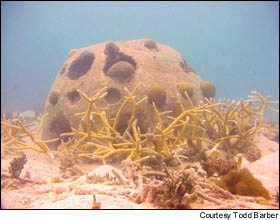| |||
|
By Phil
Bourjaily | |||
Like the towering trees of the rain forest, reefs support an extraordinary diversity of species. Like trees of the rain forest, they often take centuries to mature. And like the rain forests, they are in peril. Pollution, temperature change, dredging, ship groundings, commercial fishing, even recreational diving — all have wreaked havoc on reefs. Artificial reefs can't eradicate the causes of reef destruction, but by adding structure to the seafloor, they provide shelter for fish and a place for plants and coral to grow. They also divert anglers and divers from fragile natural systems by providing new destinations for sport. An artificial reef fashioned in the shape of the Southern Cross that serves as a snorkeling trail has eased traffic and reduced damage to Austrailia's Great Barrier Reef.
Many do more harm than good. Tires wash ashore. Appliances, cars and ships leak harmful chemicals. Heavy objects damage natural reefs as currents toss and turn them over the seafloor. Today, only concrete and heavy-gauge steel are allowed in most U.S. waters. Deliberately sunk ships must be thoroughly cleaned before they are left to drown. Structures are now being designed specially as artificial reefs, and stable, non-toxic concrete is the material of choice. The ReefBall, created by Florida diver Todd Barber, is a squat, concrete dome with lots of holes. The structure comes in eight sizes, the smallest of which is about the size of a basketball. The holes in the concrete provide cover for fish and marine invertebrates. The rough sides allow plants and coral to cling to the concrete. According to Barber, the ReefBall needs only a few years in the ocean to be fully shrouded in sea growth. The ReefBall also sits still on the seafloor, as most of its weight is concentrated at its base. Barber's company, the ReefBall Development Group, has planted 50,000 units around the world since 1993. The company sponsors reef restoration eco-tours will even mix your ashes into an "Eternal Reef" ball if your will stipulates it.
Kelp will start to form on rubble piles within a year. In 15 years, an entire community will likely flourish. Although artificial reefs no longer pollute or wash up on shore, a troubling question remains: Do reefs increase fish populations or make them easier prey for anglers? Marine officials say artificial reefs provide more habitat and increase fish populations. They also allow that angling harvests are on the rise, effectively canceling the population growth. "In some cases fish seem to prefer artificial reefs to lower-relief natural reefs nearby, but they're moving into a baited trap, because anglers know where the artificial reefs are," says Jon Dodril of the Florida Division of Marine Fisheries. Building mitigating artificial reefs when real reefs are damaged doesn't address problems of pollution, nutrient runoff and over-exploitation of the oceans, he adds.
| |||
| |||
| |||
External sites are not endorsed by ENN -- Pages will open in a new browser window. | |||
| Copyright 2000,
Environmental News Network All Rights Reserved |

|
Artificial reefs can't eradicate the causes of reef destruction, but by adding structure to the seafloor, they provide shelter for fish and a place for plants and coral to grow.
|
| LIVE CHAT | ||
| Read the transcript
from the Live ENN Chat Join a live chat with Todd Barber, chairman of the Reef Ball Foundation, about the health of the world's coral reef systems and the threats posed by pollution and other issues. Barber's organization has worked around the world to protect and regenerate coral reefs. | ||
| TAKE THE POLL | ||
| Do you think the
construction of artificial reefs is ecologically
sound? | ||
| JOIN THE DEBATE | ||
| What is the best way
to ease man's pressure on reef ecosystems?
| ||
| FEATURED BOOKS | ||
 What Is Natural? : Coral Reef Crisis by Jan Sapp — $22.50 Amazon.com Students of marine biology have long been fascinated by the superorganisms called coral reefs, formed over thousands of years from ... READ MORE & BUY  The Enchanted Braid : Coming to Terms With Nature on the Coral Reef by Osha Gray Davidson — $17.47 From The Publisher In the Enchanted Braid, Osha Gray Davidson fuses a color-drenched celebration of reefs with a fascinating natural history. ... READ MORE & BUY  Diving : The World's Best Sites by Jack Jackson (Editor) — $35.00 READ MORE & BUY | ||



